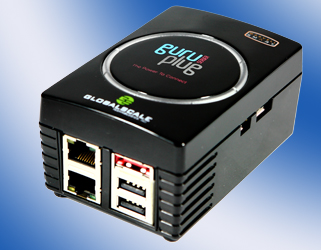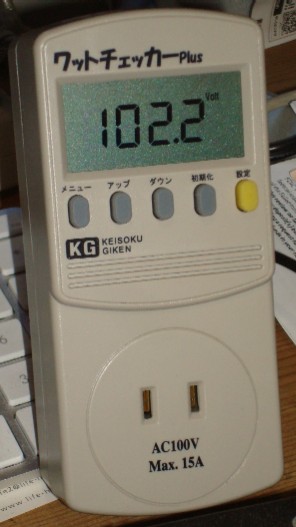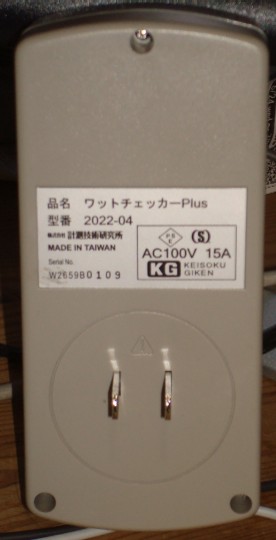The GuruPlug Server Plus that I ordered from GlobalScale Technologies in February finally arrived around the middle of May, about two weeks later than anticipated.
These ARM-based Linux computers draw a mere 5-6 Watt of power at idle according to my WattChecker Plus, yet provide as much port connectivity as a regular notebook or desktop PC. It’s a full-featured Linux server, provided your application matches the storage available (or or you add enough storage) and integer performance comparable to a Pentium III 800 MHz is adequate for your purpose.
Here’s the specification of the machine:
- 1.2 Ghz Marvell Kirkwood ARM CPU
- 512 MB of DDR2 RAM
- 512 MB of NAND flash
- two gigabit Ethernet ports
- 802.11b/g WLAN
- Bluetooth
- two hi-speed USB (480 Mbps) ports
- eSATA port
- microSDHC slot
- Debian GNU/Linux 5.0 (2.6.32 kernel)
Normally the GuruPlug boots Linux off its NAND flash (see log below), but it can be reconfigured to load an image from a microsSD / microSDHC card (4 / 8 / 16 GB) and it can also use USB or eSATA disk drives. To reconfigure the boot loader, one needs to access a serial port via a JTAG interface, one of which came bundled with my order but is also available separately. To access this serial port one needs a terminal program such as PuTTY for Windows, a micro-USB cable and drivers for the USB-connected serial port.
If you look at the GuruPlug from the top there will be two tiny sockets on the right, a narrow one with 4 pins for the serial interface and a wider one for the flash interface. Connect these to the JTAG module. Plug the micro-USB cable into the socket at the opposite end of the JTAG module, but don’t connect it to the PC just yet.
Download the FTDI driver .zip file from here into a folder and extract its contents. Modify the two files FTDIBUS.INF and FTDIPORT.INF as described here. (EDIT): Download the FTDI driver archive file from here and save it in a folder. Extract the archive within the archive and unpack it into a folder.
When you finally connect the JTAG module to the PC via the micro-USB cable, it will start the plug and play device detection for it. Windows will not find a matching driver for the two ports (“SheevaPlug JTAGKey FT2232D B”) and so you’ll need to manually chose the location where it may find the driver and INF files (the ones you extracted and edited as above).
If anything goes wrong with the device installation, you can always delete the unrecognized devices in the device manager of Windows and disconnect and reconnect the USB cable to have another try.
Configure the virtual serial port (COM10 in my case) in device manager for 115200 bps. Download and install PuTTY. Then create a PuTTY profile for a connection to the virtual serial port. When you power-cycle the GuruPlug you should see messages come up. Here is a sample of an uninterrupted boot process:
U-Boot 2009.11-rc1-00602-g28a9c08-dirty (Feb 09 2010 – 18:15:21)
Marvell-Plug2L
SoC: Kirkwood 88F6281_A0
DRAM: 512 MB
NAND: 512 MiB
In: serial
Out: serial
Err: serial
Net: egiga0, egiga1
88E1121 Initialized on egiga0
88E1121 Initialized on egiga1
Hit any key to stop autoboot: 0
*** ERROR: `ipaddr’ not set
ping failed; host 192.168.2.1 is not alive
No link on egiga1
*** ERROR: `ipaddr’ not set
ping failed; host 192.168.2.1 is not alive
(Re)start USB…
USB: Register 10011 NbrPorts 1
USB EHCI 1.00
scanning bus for devices… 3 USB Device(s) found
scanning bus for storage devices… Device NOT ready
Request Sense returned 02 3A 00
1 Storage Device(s) found
NAND read: device 0 offset 0x100000, size 0x400000
4194304 bytes read: OK
## Booting kernel from Legacy Image at 06400000 …
Image Name: Linux-2.6.32-00007-g56678ec
Image Type: ARM Linux Kernel Image (uncompressed)
Data Size: 2789756 Bytes = 2.7 MB
Load Address: 00008000
Entry Point: 00008000
Verifying Checksum … OK
Loading Kernel Image … OK
OK
Starting kernel …
Uncompressing Linux…………………………………………………..
…………………………………………………………………………..
…………………………….. done, booting the kernel.
Linux version 2.6.32-00007-g56678ec (root@msi-linux-build.marvell.com) (gcc version 4.1.2 20070925 (Red Hat 4.1.2-33.fa1)) #1 PREEMPT Mon Feb 8 03:49:55 PST 2010
CPU: Feroceon 88FR131 [56251311] revision 1 (ARMv5TE), cr=00053977
CPU: VIVT data cache, VIVT instruction cache
Machine: Marvell Plug2L Reference Board
Memory policy: ECC disabled, Data cache writeback
Built 1 zonelists in Zone order, mobility grouping on. Total pages: 130048
Kernel command line: console=ttyS0,115200 ubi.mtd=2 root=ubi0:rootfs rootfstype=ubifs
PID hash table entries: 2048 (order: 1, 8192 bytes)
Dentry cache hash table entries: 65536 (order: 6, 262144 bytes)
Inode-cache hash table entries: 32768 (order: 5, 131072 bytes)
Memory: 256MB 256MB = 512MB total
Memory: 513024KB available (5144K code, 1034K data, 148K init, 0K highmem)
SLUB: Genslabs=11, HWalign=32, Order=0-3, MinObjects=0, CPUs=1, Nodes=1
Hierarchical RCU implementation.
NR_IRQS:114
Console: colour dummy device 80×30
Calibrating delay loop… 1192.75 BogoMIPS (lpj=5963776)
Mount-cache hash table entries: 512
CPU: Testing write buffer coherency: ok
NET: Registered protocol family 16
Kirkwood: MV88F6281-A1, TCLK=200000000.
Feroceon L2: Cache support initialised.
bio: create slab at 0
vgaarb: loaded
SCSI subsystem initialized
usbcore: registered new interface driver usbfs
usbcore: registered new interface driver hub
usbcore: registered new device driver usb
cfg80211: Using static regulatory domain info
cfg80211: Regulatory domain: US
(start_freq – end_freq @ bandwidth), (max_antenna_gain, max_eirp)
(2402000 KHz – 2472000 KHz @ 40000 KHz), (600 mBi, 2700 mBm)
(5170000 KHz – 5190000 KHz @ 40000 KHz), (600 mBi, 2300 mBm)
(5190000 KHz – 5210000 KHz @ 40000 KHz), (600 mBi, 2300 mBm)
(5210000 KHz – 5230000 KHz @ 40000 KHz), (600 mBi, 2300 mBm)
(5230000 KHz – 5330000 KHz @ 40000 KHz), (600 mBi, 2300 mBm)
(5735000 KHz – 5835000 KHz @ 40000 KHz), (600 mBi, 3000 mBm)
cfg80211: Calling CRDA for country: US
Switching to clocksource orion_clocksource
NET: Registered protocol family 2
IP route cache hash table entries: 4096 (order: 2, 16384 bytes)
TCP established hash table entries: 16384 (order: 5, 131072 bytes)
TCP bind hash table entries: 16384 (order: 4, 65536 bytes)
TCP: Hash tables configured (established 16384 bind 16384)
TCP reno registered
NET: Registered protocol family 1
RPC: Registered udp transport module.
RPC: Registered tcp transport module.
RPC: Registered tcp NFSv4.1 backchannel transport module.
JFFS2 version 2.2. (NAND) © 2001-2006 Red Hat, Inc.
JFS: nTxBlock = 4010, nTxLock = 32080
msgmni has been set to 1002
alg: No test for stdrng (krng)
io scheduler noop registered
io scheduler anticipatory registered
io scheduler deadline registered
io scheduler cfq registered (default)
Serial: 8250/16550 driver, 2 ports, IRQ sharing disabled
serial8250.0: ttyS0 at MMIO 0xf1012000 (irq = 33) is a 16550A
console [ttyS0] enabled
brd: module loaded
loop: module loaded
sata_mv sata_mv.0: version 1.28
sata_mv sata_mv.0: slots 32 ports 1
scsi0 : sata_mv
ata1: SATA max UDMA/133 irq 21
NAND device: Manufacturer ID: 0xec, Chip ID: 0xdc (Samsung NAND 512MiB 3,3V 8-bit)
Scanning device for bad blocks
Bad eraseblock 1265 at 0x000009e20000
Creating 3 MTD partitions on “orion_nand”:
0x000000000000-0x000000100000 : “u-boot”
0x000000100000-0x000000500000 : “uImage”
0x000000500000-0x000020000000 : “root”
UBI: attaching mtd2 to ubi0
UBI: physical eraseblock size: 131072 bytes (128 KiB)
UBI: logical eraseblock size: 129024 bytes
UBI: smallest flash I/O unit: 2048
UBI: sub-page size: 512
UBI: VID header offset: 512 (aligned 512)
UBI: data offset: 2048
ata1: SATA link down (SStatus 0 SControl F300)
UBI warning: ubi_eba_init_scan: cannot reserve enough PEBs for bad PEB handling, reserved 39, need 40
UBI: attached mtd2 to ubi0
UBI: MTD device name: “root”
UBI: MTD device size: 507 MiB
UBI: number of good PEBs: 4055
UBI: number of bad PEBs: 1
UBI: max. allowed volumes: 128
UBI: wear-leveling threshold: 4096
UBI: number of internal volumes: 1
UBI: number of user volumes: 1
UBI: available PEBs: 0
UBI: total number of reserved PEBs: 4055
UBI: number of PEBs reserved for bad PEB handling: 39
UBI: max/mean erase counter: 2/0
UBI: image sequence number: 0
UBI: background thread “ubi_bgt0d” started, PID 454
MV-643xx 10/100/1000 ethernet driver version 1.4
mv643xx_eth smi: probed
net eth0: port 0 with MAC address 00:50:43:01:5c:56
net eth1: port 0 with MAC address 00:50:43:01:5c:57
ehci_hcd: USB 2.0 ‘Enhanced’ Host Controller (EHCI) Driver
orion-ehci orion-ehci.0: Marvell Orion EHCI
orion-ehci orion-ehci.0: new USB bus registered, assigned bus number 1
orion-ehci orion-ehci.0: irq 19, io mem 0xf1050000
orion-ehci orion-ehci.0: USB 2.0 started, EHCI 1.00
usb usb1: configuration #1 chosen from 1 choice
hub 1-0:1.0: USB hub found
hub 1-0:1.0: 1 port detected
Initializing USB Mass Storage driver…
usbcore: registered new interface driver usb-storage
USB Mass Storage support registered.
usbcore: registered new interface driver ums-datafab
usbcore: registered new interface driver ums-freecom
usbcore: registered new interface driver ums-jumpshot
usbcore: registered new interface driver ums-sddr09
usbcore: registered new interface driver ums-sddr55
mice: PS/2 mouse device common for all mice
rtc-mv rtc-mv: rtc core: registered rtc-mv as rtc0
i2c /dev entries driver
cpuidle: using governor ladder
cpuidle: using governor menu
sdhci: Secure Digital Host Controller Interface driver
sdhci: Copyright(c) Pierre Ossman
mmc0: mvsdio driver initialized, lacking card detect (fall back to polling)
Registered led device: plug2l:red:health
Registered led device: plug2l:green:health
Registered led device: plug2l:red:wmode
Registered led device: plug2l:green:wmode
mv_xor_shared mv_xor_shared.0: Marvell shared XOR driver
mv_xor_shared mv_xor_shared.1: Marvell shared XOR driver
mmc0: new high speed SDIO card at address 0001
mv_xor mv_xor.0: Marvell XOR: ( xor cpy )
mv_xor mv_xor.1: Marvell XOR: ( xor fill cpy )
mv_xor mv_xor.2: Marvell XOR: ( xor cpy )
mv_xor mv_xor.3: Marvell XOR: ( xor fill cpy )
usbcore: registered new interface driver usbhid
usbhid: v2.6:USB HID core driver
oprofile: using timer interrupt.
TCP cubic registered
NET: Registered protocol family 17
lib80211: common routines for IEEE802.11 drivers
rtc-mv rtc-mv: setting system clock to 2009-08-08 08:10:20 UTC (1249719020)
usb 1-1: new high speed USB device using orion-ehci and address 2
UBIFS: mounted UBI device 0, volume 0, name “rootfs”
UBIFS: file system size: 516225024 bytes (504126 KiB, 492 MiB, 4001 LEBs)
UBIFS: journal size: 9033728 bytes (8822 KiB, 8 MiB, 71 LEBs)
UBIFS: media format: w4/r0 (latest is w4/r0)
UBIFS: default compressor: zlib
UBIFS: reserved for root: 0 bytes (0 KiB)
VFS: Mounted root (ubifs filesystem) on device 0:13.
Freeing init memory: 148K
usb 1-1: configuration #1 chosen from 1 choice
hub 1-1:1.0: USB hub found
hub 1-1:1.0: 4 ports detected
INIT: version 2.86 booting
usb 1-1.1: new high speed USB device using orion-ehci and address 3
usb 1-1.1: configuration #1 chosen from 1 choice
scsi1 : SCSI emulation for USB Mass Storage devices
Starting the hotplug events dispatcher: udevd.
Synthesizing the initial hotplug events…done.
Waiting for /dev to be fully populated…Bluetooth: Core ver 2.15
NET: Registered protocol family 31
Bluetooth: HCI device and connection manager initialized
Bluetooth: HCI socket layer initialized
libertas_sdio: Libertas SDIO driver
libertas_sdio: Copyright Pierre Ossman
libertas_sdio mmc0:0001:1: firmware: requesting sd8688_helper.bin
libertas: can’t load helper firmware
libertas: failed to load helper firmware
libertas_sdio: probe of mmc0:0001:1 failed with error -2
Bluetooth: vendor=0x2df, device=0x9105, class=255, fn=2
btmrvl_sdio mmc0:0001:2: firmware: requesting sd8688_helper.bin
btmrvl_sdio_download_helper: request_firmware(helper) failed, error code = -2
btmrvl_sdio_download_fw: Failed to download helper!
btmrvl_sdio_probe: Downloading firmware failed!
done.
Setting the system clock.
Activating swap…done.
Setting the system clock.
scsi 1:0:0:0: Direct-Access Generic STORAGE DEVICE 9909 PQ: 0 ANSI: 0
sd 1:0:0:0: Attached scsi generic sg0 type 0
sd 1:0:0:0: [sda] Attached SCSI removable disk
scsi 1:0:0:1: Direct-Access Generic STORAGE DEVICE 9909 PQ: 0 ANSI: 0
sd 1:0:0:1: Attached scsi generic sg1 type 0
sd 1:0:0:1: [sdb] 7954432 512-byte logical blocks: (4.07 GB/3.79 GiB)
sd 1:0:0:1: [sdb] Write Protect is off
sd 1:0:0:1: [sdb] Assuming drive cache: write through
sd 1:0:0:1: [sdb] Assuming drive cache: write through
sdb: sdb1
sd 1:0:0:1: [sdb] Assuming drive cache: write through
sd 1:0:0:1: [sdb] Attached SCSI removable disk
Cleaning up ifupdown….
Loading kernel modules…done.
Checking file systems…fsck 1.41.3 (12-Oct-2008)
done.
Setting kernel variables (/etc/sysctl.conf)…done.
Mounting local filesystems…done.
Activating swapfile swap…done.
Setting up networking….
Configuring network interfaces…done.
Starting portmap daemon….
Setting console screen modes and fonts.
cannot (un)set powersave mode
Setting up ALSA…done (none loaded).
INIT: Entering runlevel: 2
Starting enhanced syslogd: rsyslogd.
Starting system message bus: dbus.
Starting OpenBSD Secure Shell server: sshdNET: Registered protocol family 10
.
Starting MySQL database server: mysqld.
Checking for corrupt, not cleanly closed and upgrade needing tables..
Starting MTA: exim4.
ALERT: exim paniclog /var/log/exim4/paniclog has non-zero size, mail system possibly broken failed!
Starting Network Interface Plugging Daemon:ADDRCONF(NETDEV_UP): eth0: link is not ready
eth0.
Starting web server: lighttpd.
Starting internet superserver: inetd.
Starting Samba daemons: nmbdeth0: link up, 100 Mb/s, full duplex, flow control disabled
ADDRCONF(NETDEV_CHANGE): eth0: link becomes ready
smbd.
Starting file alteration monitor: FAM.
Starting Hardware abstraction layer: hald.
Starting periodic command scheduler: crond.
Sat Aug 8 08:08:00 UTC 2009
uap_probe: vendor=0x02DF device=0x9104 class=0 function=1
uap_sdio mmc0:0001:1: firmware: requesting mrvl/helper_sd.bin
uap_sdio mmc0:0001:1: firmware: requesting mrvl/sd8688_ap.bin
UAP FW is active
ADDRCONF(NETDEV_UP): uap0: link is not ready
SSID setting successful
BSS started!
ip_tables: (C) 2000-2006 Netfilter Core Team
nf_conntrack version 0.5.0 (8022 buckets, 32088 max)
CONFIG_NF_CT_ACCT is deprecated and will be removed soon. Please use
nf_conntrack.acct=1 kernel parameter, acct=1 nf_conntrack module option or
sysctl net.netfilter.nf_conntrack_acct=1 to enable it.
Starting very small DHCP server: udhcpd (v0.9.9-pre) started
udhcpd.
Starting DNS forwarder and DHCP server: dnsmasq.
Starting bluetooth: bluetoothdBluetooth: L2CAP ver 2.14
Bluetooth: L2CAP socket layer initialized
Bluetooth: RFCOMM TTY layer initialized
Bluetooth: RFCOMM socket layer initialized
Bluetooth: RFCOMM ver 1.11
.
Bluetooth: BNEP (Ethernet Emulation) ver 1.3
Bluetooth: vendor=0x2df, device=0x9105, class=255, fn=2
Bridge firewalling registered
Bluetooth: SCO (Voice Link) ver 0.6
Bluetooth: SCO socket layer initialized
Agent registered
Debian GNU/Linux 5.0 sheevaplug-debian ttyS0
sheevaplug-debian login:
The initial admin password for user “root” is “nosoup4u”. Change this as soon as you can to something different.
By default the Plug acts as a broadband access point. Join the GuruPlug WLAN from a laptop and you’ll get an IP address in the 192.168.1.100-192.168.1.200 range. You can access a simple website at htpp://192.168.1.100:80 to learn more about the GuruPlug settings.
http://plugcomputer.org/ is a great resource for finding more information about setting up your GuruPlug.



